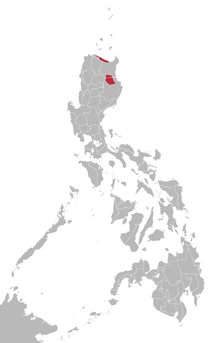Ibanag language
| Ibanag | |
|---|---|
| Ybanag, Ibanak | |
| Native to | Philippines |
| Region | Northern Luzon |
| Ethnicity | Ibanag people |
|
Native speakers
|
(500,000 cited 1990) |
| Official status | |
|
Official language in
|
Regional language in the Philippines |
| Regulated by | Komisyon sa Wikang Filipino |
| Language codes | |
| ISO 639-3 | |
| Glottolog | iban1267 |
| Linguasphere | 31-CCB-a |

Areas where Ibanag is spoken according to Ethnologue
|
|
The Ibanag language (also Ybanag or Ibanak) is spoken by up to 500,000 speakers, most particularly by the Ibanag people, in the Philippines, in the northeastern provinces of Isabela and Cagayan, especially in Tuguegarao City, Solana, Abulug, Cabagan, and Ilagan City and with overseas immigrants in countries located in the Middle East, United Kingdom and the United States. Most of the speakers can also speak Ilocano, the lingua franca of northern Luzon island. The name Ibanag comes from the prefix "I" which means "people of", and "bannag", meaning river. It is closely related to Gaddang, Itawis, Agta, Atta, Yogad, Isneg, and Malaweg.
As of Oct. 2012, "revival of the Ibanag culture is part of the Mother-Tongue Based (MTB) program of the [Philippine] government which seeks to preserve indigenous cultures, including its languages, for generations to come. Ibanag is one of the MTB languages now taught in Philippine schools," and two current stage plays, “Zininaga Ta Bannag (Heritage of the River)” and “Why Women Wash the Dishes” are being performed in the Ibanag language.
Monophthongization of diphthongs is observable in Ibanag. For example, the words umay (to go), balay (house) or aggaw (day) are sometimes pronounced as ume, bale, and aggo respectively.
Ibanag is also one of the Philippine languages which are included in the [ɾ]-[d] allophony.
...
Wikipedia
